After our descent from the tower, we
headed over to the Deutsches Museum (of science and technology).
Established in 1906, the museum consists of more than
12 miles/19 kms (!) of corridors filled with
exhibits on aeronautics, physics, chemistry, printing, ceramics,
musical instruments and much else! It is a truly amazing place, with
lots of working models, demonstrations, buttons to press and hands-on
exhibits. We spent over three hours there and barely touched the
surface of what there is to see on just one of the floors. A small sample of what we saw
is displayed below: some of the the nautical exhibit (remember, these are full-sized ships, etc.), of the many planes and rockets on display, and of the incredible variety of musical instruments.
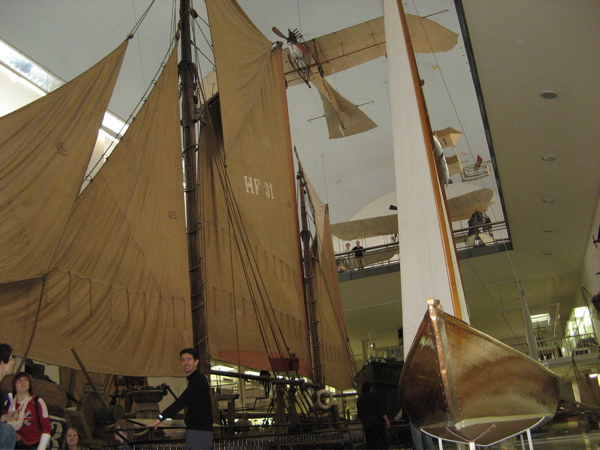


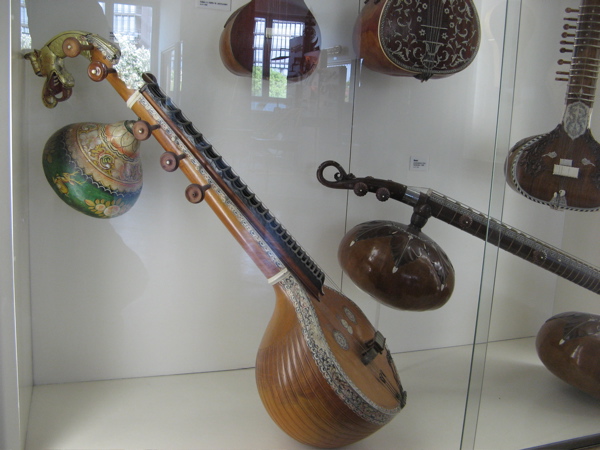
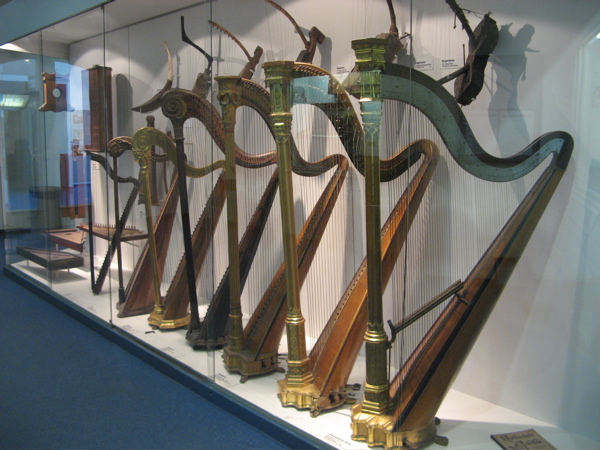
We sat in on a chemistry demonstration with burning elements, cannon
shots and general fun. Below, Gerald is seen testing if angular
momentum really is conserved [it is] by pulling dumbbells in and
pushing them out to change his spin-speed.
Olympic ice-skating competitions are next for him. The
contraption in the center photo is actually the original of
Otto von Guericke's "Magdeburg Hemispheres", created in the early
1600's as the first artificial vacuum. Apparently, after pumping
out the air from inside, two teams of eight horses could not pull it
apart. On the right is Gerald in one of the mirror exhibits we
played in for a while .
There was a lot of fun stuff that we played with, even more that
we saw; and we
missed seeing much more than those two combined!
Definitely worth the visit.
It was mid-afternoon by the time we were leaving the museum.
Friends had recommended that we visit Andechs, an old Benedictine
monastery outside of town that has been brewing its own beer for over
500 years. We thought they might have gotten the technique right
by now, and
had decided to go there for dinner. We knew that it took about an
hour to walk from the train station in the town of Herrsching up to
the monastery, so we thought we'd go out early and enjoy the afternoon
/ evening there. We got the subway to Herrsching, noting that
there was a message scrolling beneath the sign for it that we couldn't
quite
understand. Ends up that there was construction going on, so for
the last 7 stops we would be taken by bus to Herrsching rather than by
train. The sky had been threatening rain all afternoon.
Just before the bus arrived for the beginning of this
alternate-transit journey, the thunder and lightening started.
The rain
came just as the bus pulled up. We figured we had timed that well
and accepted that we would need to take a bus or taxi up to the
monastery if it hadn't stop raining by the time we arrived in
Herrsching. It kept raining. Hard. Then the hail came.
Lots of it. It was still pouring by the time the bus
dropped us off at the Herrsching train station. We were soaked
just from getting off the bus and running to the train station that was
about 10 feet away. We waited around for a taxi, but none showed
up. The next (and last) bus up to the monastery didn't leave for
40 minutes. We decided that even if we waited to take that bus
up, if we couldn't find a taxi at the main train station in town, we
were not likely to find one up at the monastery for the return trip.
It just wasn't worth the risk. So, we got on the next bus
back that met up with the next subway back to central Munich. It
was a long
trip, but we saw the countryside and stayed relatively dry for those 2+
hours! Plus it felt good to sit after having walked all morning
in town and the museum. When we got back to Munich, we went back
to the hotel for hot showers and a change into dry, warm clothes.
We had passed a nice-looking café on our way back to the hotel the night
before, so we went there for dinner. It had cleared enough by
then that we were able to take a walk around a different part of town
that was a bit more "European" looking, with grand avenues and
buildings. We had decided to have dessert somewhere different,
but it took a while to find something reasonable. We ended up at
a Greek restaurant (we could tell by the live music more than anything)
and ended up having a hot cup of tea.
Sunday started out with another huge, yummy breakfast. On our way into town, we stopped
in at the Asamkirche (Asam church, named after the Asam brothers, the architects
who designed the church), built between 1733 and 1746. It would have been
easy to walk by it without thinking much of it (see below, left) if
friends and guidebooks had not suggested we visit it. As opulent as we
thought the other churches were, they were
plain compared
to this one! Quite literally every part of this church is
decorated - by murals, statues, gold or marble (see below - use the
people in the right picture for a sense of scale!). It was
astounding
to see.
Our "big" destination for the morning was the Residenz, a complex of
buildings (and gardens and courtyards) that housed the Bavarian rulers
from 1385-1918. The complex covers a large area, but only some of
it is available for viewing. Our first stop in the complex was the
Schatzkammer, or Treasury, started by Duke Albrecht V (a Wittelsbach
duke) in 1550 and added
on to from then. Talk about wealth! These guys were loaded.
Some of the many spectacular pieces on display were very
pretty. Some were hideous. But most of them reflected
incredible
craftwork. We couldn't stop shaking our heads in wonder.
The few we've shown below are: one of the
many
crowns on display (wouldn't want to use the same one for different
people, especially since the rulers came from various areas at
different times); a toiletries bag (would be great for camping!);
and a jeweled desk clock. One statue of St. George (not
pictured) has 2,291 diamonds, 209 pearls, and 406 rubies. That
could keep a small country going for a while!
After a brief rest outside in the courtyard, we headed into the
Residenzmuseum, with its 130-odd rooms. The first stop was the
Grotto Court, built in the 1580s - so garish (see below) it almost
looked pretty! But the next sight took our breath away. The
Antiquarium (see below) is 69m/226 ft long and is covered with a
barrel-vault ceiling filled with murals of German towns/castles.
The walls are lined with antique busts and statues collected by
Duke Albrecht V. Apparently the room is now used for state
functions. We don't know if we know enough people to fill the
dining room table, but we're willing to try! Truly spectacular.
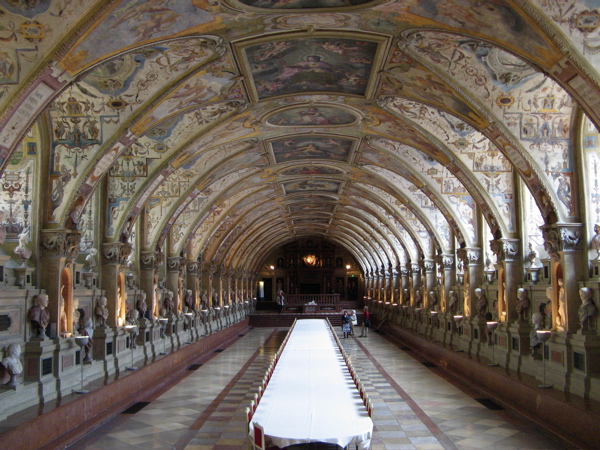

We continued along the "tour route" of the rooms and realized that we
had timed our visit perfectly. Usually there are different
"routes" (rooms available to visit) for the morning and afternoon.
However, we were there around 12:30 pm, so we were able to see many
more of the rooms than we would have otherwise! There were rooms
devoted just to the Porcelain collection (with over 700 pieces in just
ONE of the many patterns - one made with Onyx) and to an Asian
collection; and then various apartments, antechambers, receiving rooms
and bedrooms for the royalty. Each was ornately furnished - often
with similar pieces to the originals (that had been bombed out).
Two other spectacular rooms were the Gallery of Ancestors and the Green
Room (see below). The Gallery of Ancestors was built in 1726 by
Elector Karl Albrecht and contains over 120 portraits of the rulers of
Bavaria, including Charlemagne. This wasn't just a nostalgic way
to remember the family, but also served to show the important
connections the Wittlesbach dynasty had made through marriage.
This information was used by the to make his "case" for becoming
Emperor. It worked. He was crowned Emperor of the Holy
Roman Empire in 1742. Public relations has been used for quite a
while.... The Green Room (so named because of the green silk
"wallpaper") and adjoining Cabinet of Mirrors were spectacular with
their gold decorations, mirrors everywhere and chandeliers (must have
been even more dramatic when these were filled with shimmering
candles). Hard to capture its elegance, but we kept trying!
We walked around some of the courtyards and stopped into the
Theatinerkirche (the yellow one pictured below). It was
commissioned in the mid-1600s by one of the Electors and his wife in
thanksgiving for the birth of their son/heir. You know, a little
something for the people.... We then sat in the one of the main
gardens of the Residenz complex and munched on a pretzel (the bready
kind that they sell in NYC) while listening to a cellist play in
Diana's temple in the center of the garden (see below). Very
relaxing. In Munich, most of the museums are either free or have
reduced entry fees on Sunday, so we decided to push ourselves on to see
more.
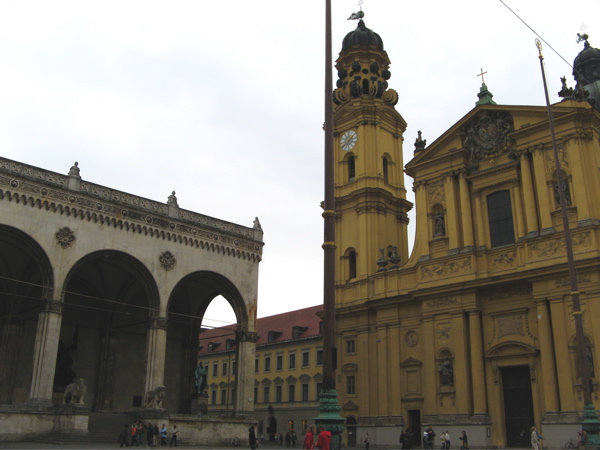
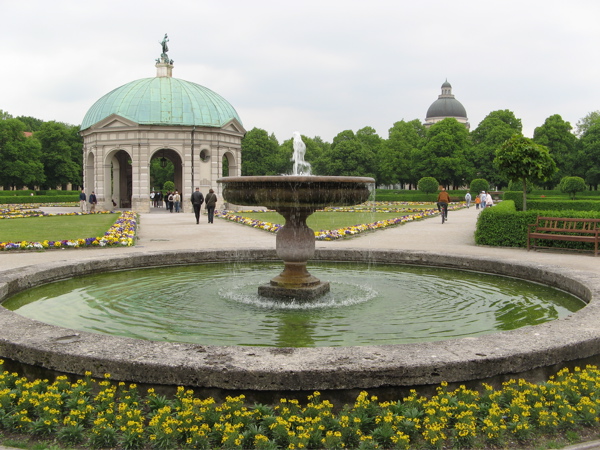
We walked up to the Schwabing neighborhood, about 15-20 minutes away.
Apparently this used to be the artsy, bohemian neck-of-the-woods, but
has been gentrified a bit. We headed first to the Glyptothek, a
sculpture gallery with works from ancient Rome and Greece. The
building itself is modeled after a Greek temple and there used to be
colorful frescoes inside, but those were destroyed in WWII (although
they had pictures of them and they looked fantastic). Luckily the
statues/art had been stored safely. We forced ourselves to walk
through fairly quickly (as this was not our final destination), but
enjoyed it immensely.
Our "final" museum for the day was the Alte (Old) Pinakothek.
The original building was built in the early 1800s to house the
ever-growing Royal collection of art. It was the largest gallery
of its kind at that time (it is 127m/417 ft long) and it houses an
incredible collection of works by "old masters," including Dürer
(whose home we had visited in Nürnberg), da Vinci, Boticelli,
Rembrandt, Titian and many others. We knew we would run out of
steam if we went at the pace a place like that deserves, but enjoyed
seeing it all.
It's tiring just
thinking
about all that walking - especially museum-paced walking! We
found a gelati shop to help us re-energize and walked around the
neighborhood a bit to scope out potential dinner spots. We walked
back toward our hotel through the English Garden - one of the largest
gardens in Europe - and came across an unexpected sight: surfers!
There is an artificial wave created near one of the bridges over
the Isar river that runs through the garden and there were a bunch of
folks surfing! We aren't kidding -- see below. It was fun to watch, but somehow sad.
After a hot shower and short
rest at the hotel, we headed back to Schwabing (via tram - our legs
were pretty tired by now) and found a café for dinner.
We got another gelati for dessert (different flavors this time!),
wandered around the neighborhood a bit and then headed back to the
hotel for a well-earned night's rest.
Our train back to Heidelberg did not leave until Monday afternoon, so
we slept in, pigged out and then headed over to one of the few museums
open on Monday: the Neue (New) Pinakothek. We knew that we were
on the edge of being museumed-out, but thought we'd spend an hour or so
there (we didn't know if we had the energy to walk around town all
morning!). This building was built in 1975-80 to replace the original
(built in 1846-53) that was destroyed in WWII. It houses a
collection of art from the 18th and 19th centuries that included some
Impressionists and other nice pieces. We went through it fairly
quickly, but enjoyed what we saw. We had time, so we decided to take a
tram up through the English garden a bit more and back through an area
we hadn't explored yet. It was a relaxing way to see more of what
proved to be a pretty city. We returned just in time to collect
our luggage and head over to the train station for our trip back to
Heidelberg.
EBERBACH / HIRSCHHORN
We were considering what to do on Sunday (wanting to limit our travel
time to under an hour) and Holger suggested a few towns nearby:
Eberbach and Hirschhorn. We looked at the train table and
realized that the train stopped at Hirschhorn on the way to/from
Eberbach and that there was only a 6-minute trip between the two.
So, we decided to try something new! We took our bikes on
the train (that's allowed - and free on the weekend) and went directly
to Eberbach. We found ourselves in the midst of a beautiful medieval
town. The town dates from 1227, and the (ruins of)
the castle (which we were too lazy to climb to visit) from
1190. We wandered into a very colorfully decorated market place (see
below, left) and sat down for a nice lunch. It was a nice, warm
day and we wandered around for a while - mostly to wait until a
couple of the local museums opened (at 2 p.m.). We came across
these fun statues, as well as many water fountains with interesting
sculptures/decorations. We ducked into the Coopers' museum and found it
in an old workshop, filled with old tools and samples of the barrels
they made (below, right). Luckily they had some of the
explanations in English. One of the guides sat down at the planer
and shaved off a few pieces of the hard oak they used. It was
clear how hard the wood was - and one could see the even growth rings
they had noted helped to make the barrels strong. There was also
a case showing the fairly sophisticated geometry involved in designing
and creating the various shaped barrels. It was much more
interesting than we expected - and very impressive, actually.
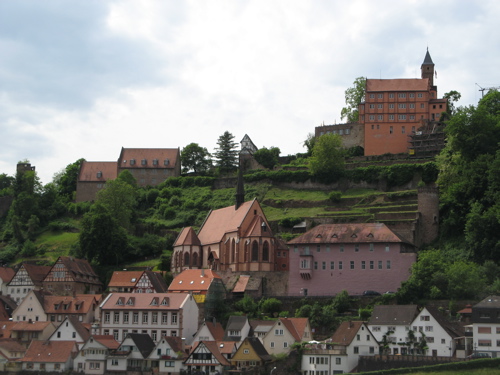
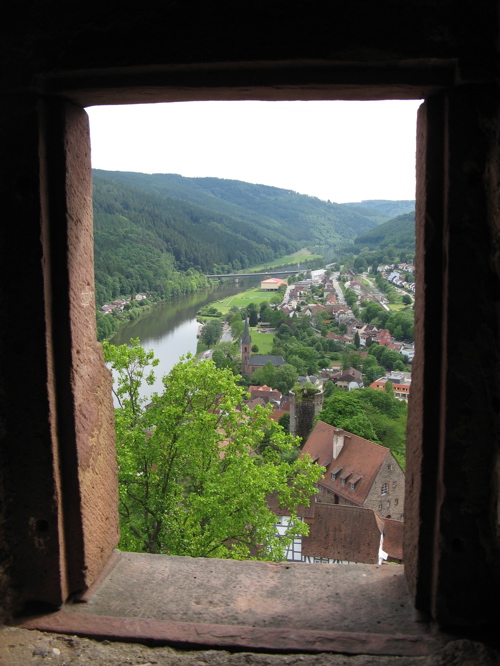
We explored the town a bit, mostly
conducting a reconnaissance mission to decide on the best spot for an
ice cream, and chose a place with a view (pictured below, left) of one
of the town's gates. Elyse's order ended up being a LARGE bowl,
filled with delicious vanilla ice cream, and covered with lots of fresh
strawberries and a pile of cream. Luckily the strawberries and
cream went with Gerald's lemon gelati. Otherwise, we might still
be there waiting for Elyse to finish. Not that that would be a
bad thing.... As we biked around on our way to the train station,
we found a different view of the castle that we liked. It was a
lovely day - not bad for one with no planning. We think Holger should
write a travel guide book - we've done very well by his recommendations!
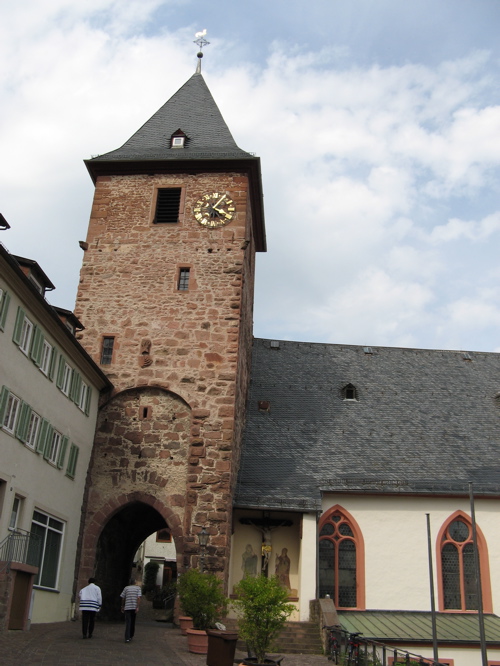
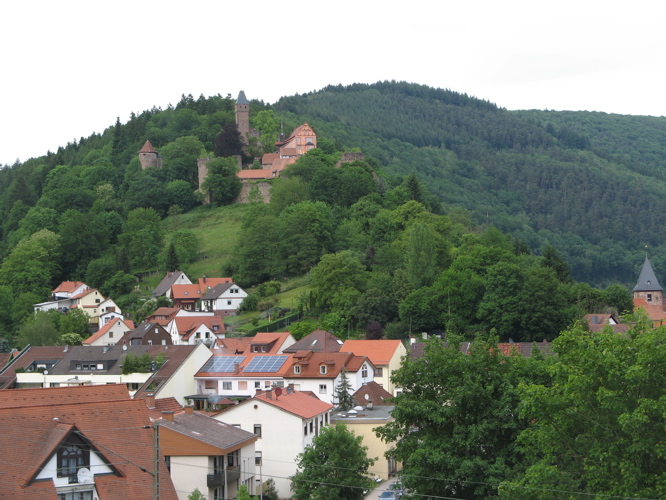
PISA / LUCCA
Gerald was invited to give a talk and
work in Pisa for a few days, so we left late Tuesday night (we need
to spend some time
in
Heidelberg!)
and arrived at our hotel to find that we were staying
right next to [i.e., about 100 metres from] the Campo dei Miracoli (with the leaning tower, etc.)!
The tower is on an incredible angle (see below) and the whole
area was quite spectacular, so we took a quick walk around before
heading to bed. The view on the right is from our hotel window. You can
see how the stone changes color depending on the sunlight - the one on
the right is in the evening. Elyse sometimes has trouble with taking
straight pictures, so this looks like the whole complex is leaning!
It
does seem that way (it is very marshy land), but to this extent!
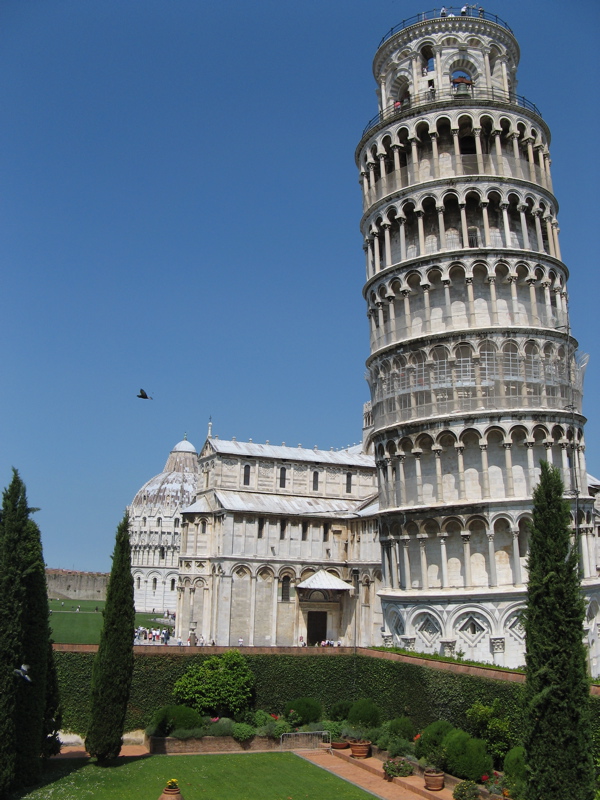
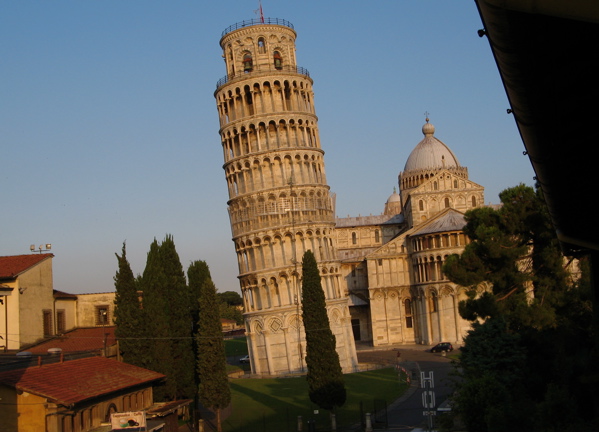
Pisa was a powerful maritime city in the
early middle ages. After
defeating the Saracens in the 11th century, many of the scientific and
artistic achievements of the Arab culture were brought back to the
city. They were defeated by Florence in 1406 and ruled by the
Medicis,
who re-established the university and encouraged the arts and learning.
After getting Gerald set up at the University the next morning
(his talk was that afternoon), Elyse headed back to the Campo
dei Miracoli (Field of Miracles) to visit the various monuments there.
Although it
looks like they were all built about the same time and designed by the
same architects, in fact they were built over about 300 years by
different folks. But they all go together quite nicely, don't you
think?
There are five major sights at the Piazza - other than the tower itself - to
visit. Elyse began her tour with the Cathedral, started in 1064
to commemorate a
victory over the Arabs in Palermo. At this time Pisa was one of
the richest and most powerful cities in the region. The cathedral
was designed by an architect named Buscheto who incorporated aspects of
many different cultures - Byzantine, Arab and Classical included.
There are (both here and in other monuments) beautiful sculptures
and other works of art by Nicola and Giovanni Pisano as well. As
you can
see below, it is quite ornate inside. The view on the right is
looking up at the ceiling and dome. Legend has it that the lamp
shown inspired Galileo's understanding of the pendulum because of
how it
would sway.

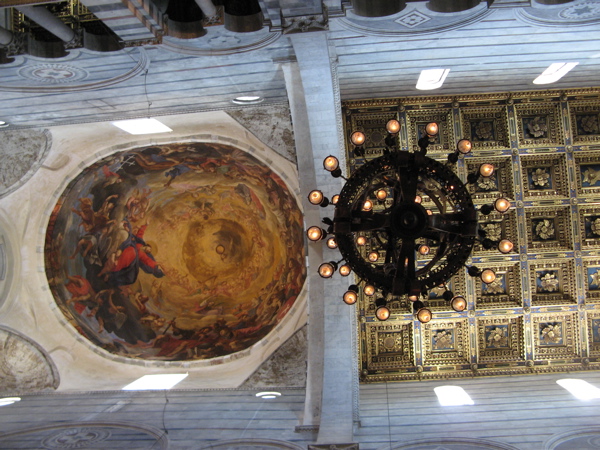
Stop number two was next door at the
Baptistry. It is the building peeking out on the left at the back of the
left photo above. This building was started in 1152, but wasn't finished
until the end of the 14th century when they added the pear-shaped dome.
It has a circular plan that mimics the Pantheon (in Rome) and is relatively plain inside,
apart from
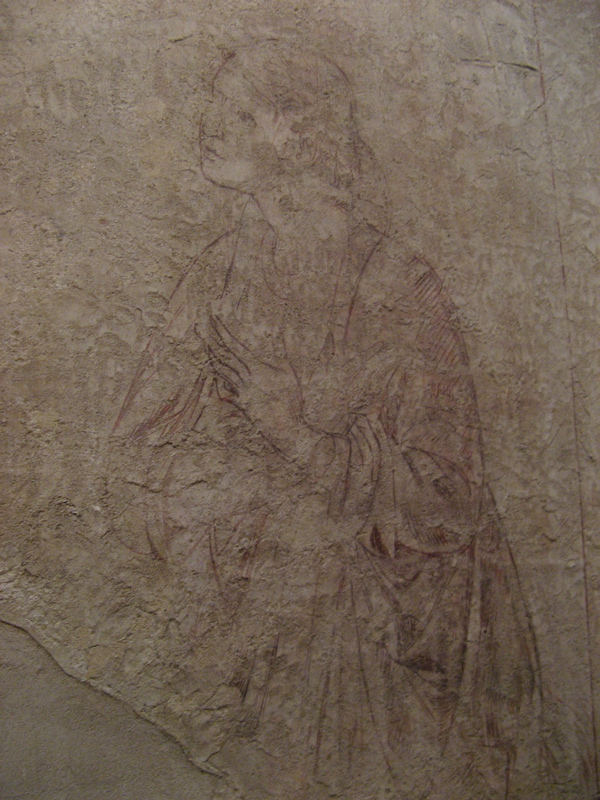
beautifully designed tile floors and an octagonal baptistry font.
You probably can't see it in the picture, but the roof has two
different materials covering it: half is in terracotta tile and half is
iron. The theories we heard for this were: 1) that the sea air
would have rusted the metal, so the side facing the sea has the
terracotta; 2) they ran out of money; and 3) it was a fashion
statement. You choose.
There are two museums on the piazza, so Elyse decided to visit one
before lunch and save the other one for after. The first museum
she visited
was the Museo delle Sinopie. The name "sinopia" comes from the
red ochre pigment that was used in the middle ages. The sinopia
here are the rough sketches that were made just under where a fresco
would be painted (to guide the
artist). A whole series of these sinopie were revealed when
frescos were damaged / fell off the walls of the Camposanto (still to
come in this tour) during WWII. They are clearly quick sketches,
but there were some beautiful scenes, including this woman sitting
(pictured right).
Apparently it was more likely that the sinopie would be done by
the masters, while the final frescoes might be carried out by
assistants. The walls of the museum that were completely covered
with these sinopies were huge.
Quite impressive.
It was a beautiful day and Elyse needed a break from all this
"culture", so she decided to walk around town a bit and then head down
toward the river for lunch. It was fun to walk through the windy,
narrow streets. Buildings in Pisa are often painted in a golden
yellow or rusty orange and have dark green shutters. It is a
beautiful combination of colors, especially when the sun hits it (see
below). There
are a lot of tourists in Pisa, but most are concentrated around the
Miracoli complex. It is a university town, so there were a lot
of students and lots of cafés and restaurants.
Unfortunately, there are busy streets on either side of the river
(below, right) and no restaurants overlooking the water (Elyse
considered just having
gelati for lunch, but thought better of it since we were probably not
going to have dinner until about 8:30 p.m.). So she decided to
wander
back toward the Campo dei Miracoli. She chose a café with
a view of the leaning tower - because she could - and had a
pizza. Luckily she timed her stop just as a tour group was
leaving the restaurant, so it was a pretty relaxed lunch.
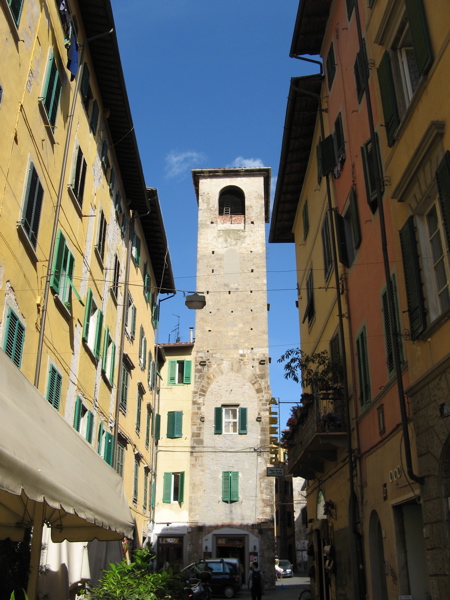
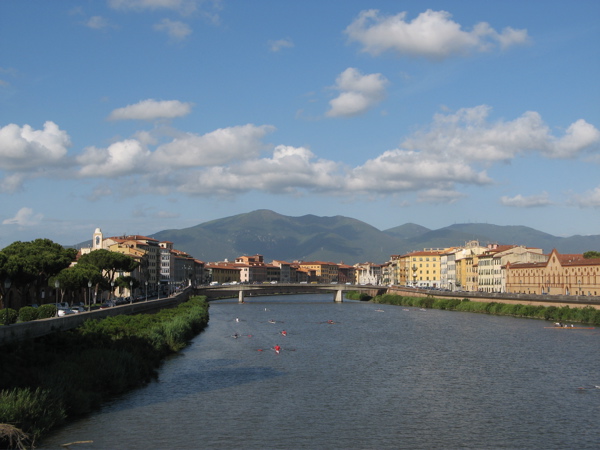
Replenished and rejuvenated, Elyse headed next to the Camposanto, or
the monumental cemetery (Campo Santo means sacred field and became the
Italian word for cemetery). Sounds pretty morbid (and it is if
you think about it, so we didn't). This building was started in
1277. Its outer marble wall serves as the northern boundry of
the piazza. Its inner walls, ornately decorated with the columns
pictured below, create an inner "sanctuary." Originally, this center
bit was covered with "holy" dirt brought back from Palestine after the
first crusade (apparently tons of this dirt were brought back to Europe at that time).
Sarcophagi were then placed in this open area, while more
"modest" graves were placed in the corridors around the walls pictured
below. By the end of the 14th century, the walls were completely
covered in frescoes focused on the themes of life and death. One
famous one was Buffalmaco's "Triumph of Death" that is now displayed in
a separate, covered room at Camposanto. (Piece of trivia for you: Buffalmaco is
believed to be featured as a joker in Bocaccio's Decameron stories of the plague.) One of the
three full walls of this room (with just
this fresco) is pictured below (center), along
with a detail of one of the panels (right). Remember that this is just
one of the
many
frescoes that
covered the entire Camposanto. Most of them were damaged /
destroyed in a fire during WWII, and many are being restored
(there were some folks working on one of the walls during Elyse's
visit). The center picture should also give you a
sense of the scale of the sinopia (sketches) Elyse had seen in the
first musuem. Pretty incredible.
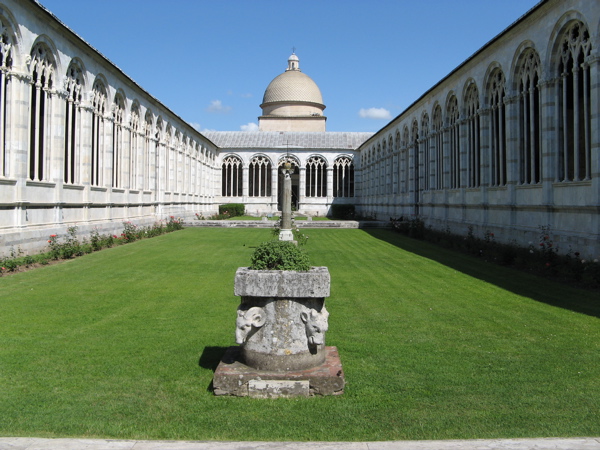
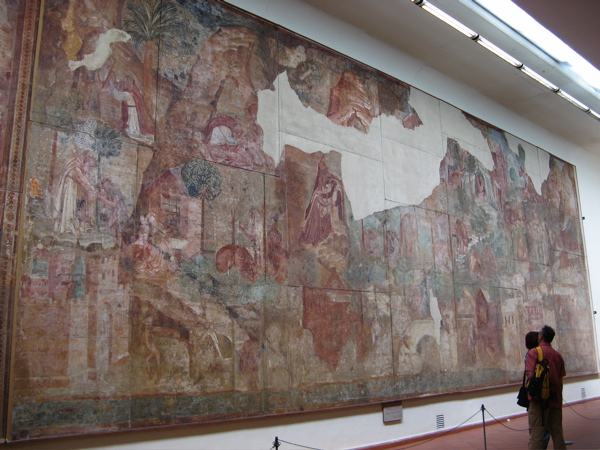
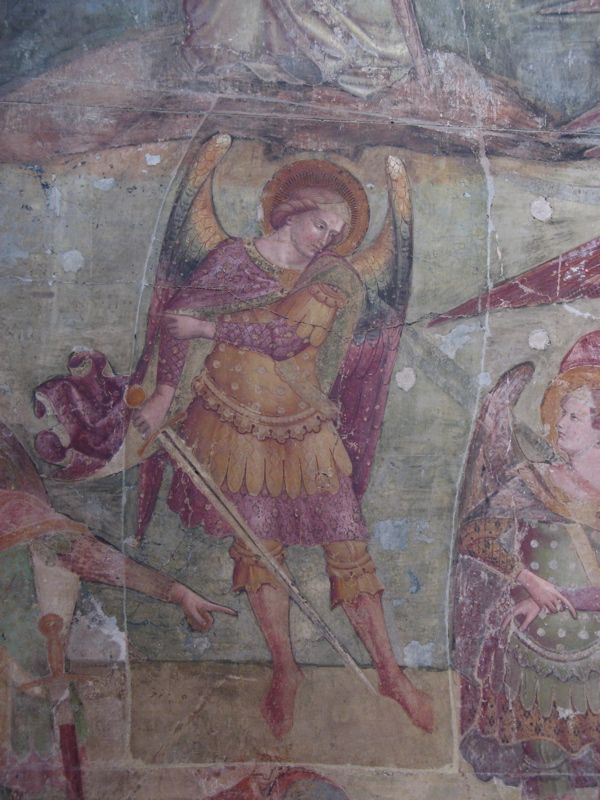
Elyse's last stop of the day was the
Museo dell' Opera del Duomo. This museum was only opened in 1986
and is housed in an old Capuchin convent. Ends up it is
filled
with original treasures from the other places she had visited earlier
in the day, along with better explanations of each of those other sites
than any of them had had! If any of you ever goes to Pisa, go to
this museum before you visit anything else there. It really is a
beautiful spot (the view of the tower at the beginning of this section
is from its courtyard). It includes many of the examples of
Islamic art (colored tiling and the griffin pictured below; a copy of
the griffin sits at the top of the Cathedral), along with statues and
parts of columns and capitals, silver and gold pieces of art from the
cathedral's treasury, relics, illuminated scrolls (back-to-back with
the words so that the illiterate congregation would be able to follow
the "story" with the pictures as the priest unrolled the scroll), part
of a red sash that would be wrapped around the cathedral on special
occasions (imagine how long
that must have been!), Egyptian art, a bust of Julius Caesar (supposedly made by a
contemporary), and much more. It would have been best to have seen this
first, but it was a lovely way to end the visit.
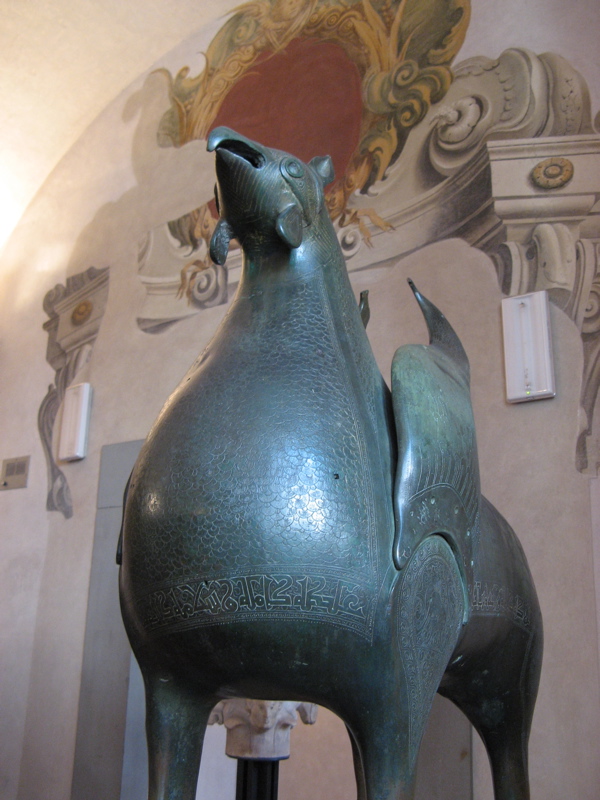
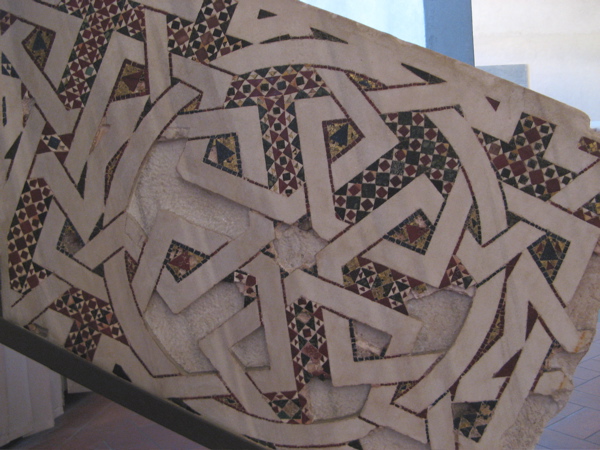
There was still time left before we were
supposed to meet at the hotel, so Elyse decided to wander around town a
bit more. More narrow streets to explore, hidden courtyards and
piazzas to find, people to watch and languages to hear. It was a
relaxing ramble around town before she headed back to the hotel.
We met Gerald's host, Ken, and his wife (also a physicist at
Pisa) for dinner at a small restaurant not far from the university.
The food was delicious and they are very nice people.
Gerald ordered Cantuccini (like biscotti/mandelbread) and Vin
Santo (a dessert wine) for dessert. He received a pile of
biscuits (that are supposed to be dunked in the wine before being
eaten) that could have lasted us a week! We helped him a bit and
managed to finish almost all of them. A great meal.
On Thursday, Elyse stopped by another museum down by the river that was
filled with religious art - statues, painting, altars, etc. She
confesses (pun intended) that it was a bit much, so she went through it
fairly quickly. In any event, her plan for that day was to visit
the nearby town of Lucca,
so she wanted to get going anyway. Ends up that the next train to
Lucca didn't leave for over an hour after her arrival at the train
station, so she sat at a cafe and nursed a
tea and a pastry before catching her train (more people watching and
details on buildings to notice, like a ship design above a window and a
dragon weather vane!).
Lucca is a nearby fortress town where, in 56 BC, Caesar, Pompey and
Crassus agreed to rule Rome as a triumvirate. Needless to say,
it's been around for a long time! One of its most impressive features
is the 4200m (about 14,000 feet) of uninterrupted walls that surround
the city. They are more than 10m tall, up to 30m wide at the base
and are dotted with 10 fortified entrances! Once again, Elyse
enjoyed wandering among the narrow streets (often even narrower than
Pisa's!) and finding hidden gems of places. There were a lot of
tourists walking around, including many Germans, so she had to keep
reminding herself that she was not in Germany and to remember to say
"per favore" and "grazie" instead of "danke" and bitte"! Very
confusing.
The first (of many) churches that Elyse came upon was the Duomo, started in 1063, that has an
incredibly ornate facade and, inside, a beautiful tomb sculpture of
Ilaria del Caretto (from 1406). Photographs weren't allowed, but
Elyse really wanted to show Gerald how beautiful the statue is, so she snuck
one in - here it is for the rest of you to share (as
accomplices to Elyse's crime).
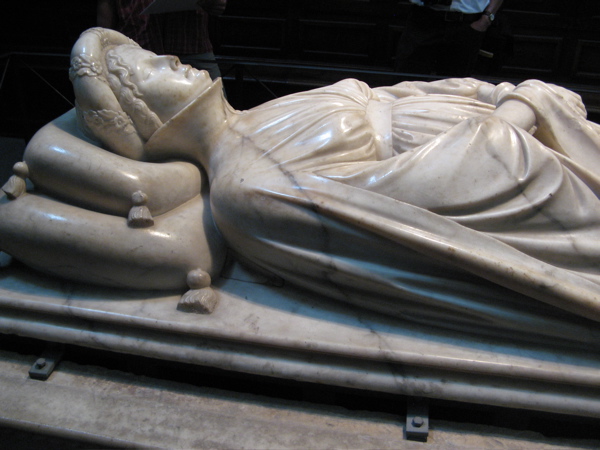
There were lots of other ornately
decorated churches and squares around town - we won't bore you with
all of the
details, but it is clear that these people had a lot of money to spend
on their architecture and art. One incredibly bizarre sites was
this mummy of Santa Zita, the patron saint of domestic servants, found
in the church of San Frediano. At least we know they appreciated
their servants! Elyse can't wait to gross out her classes with this picture!
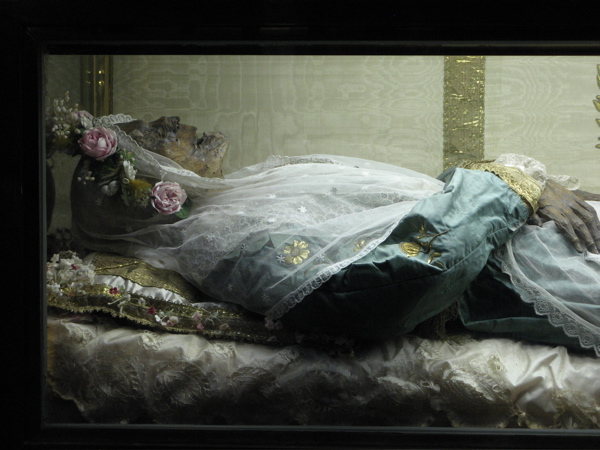
Although it was early afternoon and she
was hungry, Elyse came across the
Palazzo Mansi and decided to go in. It was "culture week" so
admission was free. This place is a museum that
had been the palace of a rich family
from the 16th to the 19th centuries. The picture below gives you
a taste of how ridiculously luxurious their rooms were decorated.
This is the bedroom and it (along with 4 other rooms) was
completely covered with
tapestries. This being the master
bedroom, it had more gold than the others, but there was certainly no
bare space on the walls or ceilings! No plans to redecorate our
bedroom in this style, but incredible to see. There was quite a
collection of
paintings, too. How the other .00005% live....
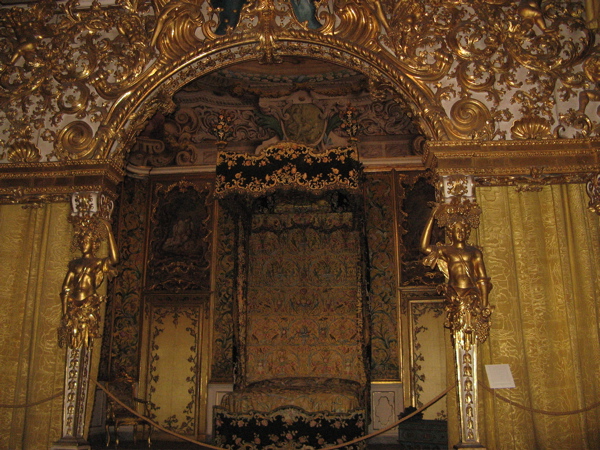
There was a simple outdoor café
nearby, so Elyse ordered some pasta for lunch and sat for a while to
watch the people and figure out what to do next. Her curiosity
was peaked by a
comment in the guide book that said there was a tower with a tree's
roots growing into the room below. It was supposed to have nice
views of the town, so she headed over there. On the way over, she
went by the old Roman amphitheater. The sides of the amphitheater
have been replaced by medieval
houses (see below) that now have shops and restaurants in the ground
floor.
It's a nice spot (but it would have been even more cool to see
the original structure!).
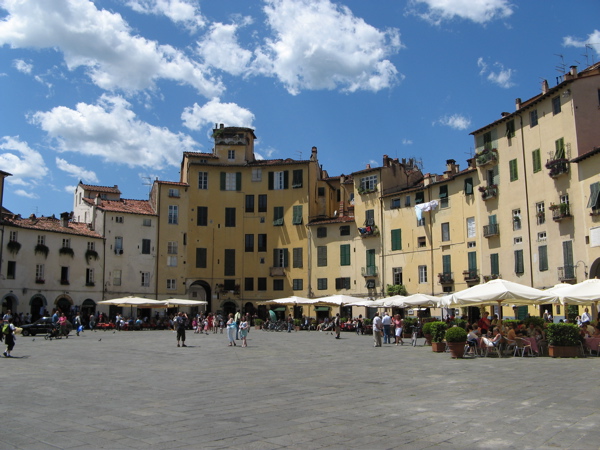
Although the morning
had started off a bit overcast and cool, the sky was clear and blue and
there was a soft breeze blowing. The walk up the tower stairs
wasn't too bad and the top provided some pretty amazing views out to
the mountains and across
the town. This is where one can really tell how close the houses
are to each other and how many terracotta roofs can fit into a small
area! You can also see (a bit - to the right of the tower, with
the light yellow facades), the outline of the old Roman amphitheater.

After walking around a bit more, Elyse
headed back to the train station. It had been another relaxing,
rambling
day. Apparently it was a productive day for Gerald, with good
discussions with the folks there. We ended up meeting up with
about 6 other people for dinner,
including Gerald's host, some other physicists and some "significant
others", including one guy's dad who was visiting from Denmark.
He is a stone mason, so we're sure he was appreciating the
artwork that much more! It was a fun evening with more
delicious food and
wine and lots of laughter. A nice way to end the day.
Elyse's plan for Friday was to visit Florence (only an hour's train
ride from Pisa). She had mentioned this to Ken on Wednesday and
he had suggested that Gerald join her. So, with
permission for Gerald to "play hookey / bludge", we both headed
off to the train
station Friday morning and got our ticket to Florence. When we
went to the track, however, there was no train. We asked an
official-looking person who said in broken English that there was no
train to Florence that day. We didn't think it was a holiday or
anything, so we were very confused. To make a long story short,
there was a train strike that day. Folks suggested going to
Florence on Saturday instead, but we were flying back to Heidelberg on
Saturday, so we knew that wasn't an option. After weighing all
our options (including a 3-hour bus ride to Florence), we decided to
go to Lucca together. It was fun for Elyse to share some of the
gems she had found, and for the two of us to find many new ones.
We went back to the Palazzo Mansi because no description can
fully capture the decor there, stopped into many of the churches,
visited the amphitheater, walked on the walls for a while and found a
little trattoria where we had
fantastic risotto for lunch.
One of the new spots we visited was the Palazzo Pfanner. The
villa and gardens are from the 17th century. Many of the exhibits
inside were about the doctor-owner, Pietro Pfanner, including many of
his surgical instruments that made Gerald a bit queasy. The
doctor was apparently a very good person and would often provide
financial support to his poor patients. It was a "feel-good"
story that made us, well... feel good! The gardens are beautiful
and we sat in them for a while enjoying the peace and quiet and colors.
We decided to go back up the Torre
Guinigi that Elyse had climbed the day before because it was a
beautiful day and she knew that Gerald would appreciate the view as
well. We were able to sit on the inner wall (surrounding the huge
trees that grow at the top of the tower) and enjoy the breeze and views
for a while. We very much enjoyed wandering around together.
We hope that we'll go to Florence together one day, but it is
doubtful that we would have gotten to Lucca together otherwise, so it
worked out well.
We went back to the hotel and rested our weary feet (Elyse even
indulged in a hot bath!) before heading out to dinner. Gerald had
spotted a small restaurant, La Stanzina, near where we had gone with
the group the night before, so we went in there. It only has
enough space for 25-30 people and we were the first ones there. It was
7:30, so we were
way early by
Italian standards. The chef greeted us and asked for 5 minutes to
have his cigarette before we "got started." He was very friendly
and it set the tone for a wonderful evening. The food was
delicious - the chef said he just was copying his Sicilian
grandmother's cooking. We started with a pasta with pistachios
and a cream sauce that was superb. For the main course, Elyse had
a delicious swordfish and Gerald had a rolled veal that was out of this
world. We shared a canoli for dessert and seriously considered
ordering a second one because it was so good. But we decided
(after a long time) to walk around a bit and get a gelati somewhere
instead... not because we were hungry or anything, but because it was
our last night in Italy. We ended up having one of the best
peach gelatis we had ever tasted. We wandered through
the narrow streets and piazzas before returning to the Campo dei
Miracoli. There was a sliver of a crescent moon rising "between"
the buildings on the piazza, making it all that much more impressive
looking.
Saturday morning we had planned for Gerald to see some of the monuments
and for the two of us to climb the tower. It was a bright, clear
morning and we booked an early time to go up, so it was not too
crowded. They are pretty strict about the number of visitors and
the timing of the visits (every 30 minutes early in the day and then
every 20 minutes later on!). The tower is still moving, albeit
slowly and they have considered stopping allowing any visitors (due to
the pressure on the structure, etc.), but the Pisa tourism bureau
doesn't really want to give up the millions of Euros that it earns
every year from suckers like us who want to make the climb. They
continue to work on stabilizing it.
We did not expect to
feel the
"lean" quite as much as we did - both when we were climbing the spiral
staircase and, especially, when we got to the top. It was a bit
spooky, and we had to give ourselves (our brains?) some time to adjust.
In the pictures below, the camera is straight - it's the "floor"
of the tower and the bell that are crooked! We had beautiful
views of the city and of the complex below us (you can see the roof of
the baptistry in the back and the size of the cathedral in front of it.
The cemetery complex is the long rectangle on the right side.),
and even got to hear the bells ring (loudly - Elyse was startled
despite the warning announcement before they rang). As much as we
had felt the angle on the way up and walking around the top, it was the
descent that was most jarring. When we were on the leaning "side"
of the spiral staircase, we felt as if we were going to fall forward.
Considering the marble steps were almost "wavy" from being worn
down (unevenly) over the centuries, we were using the walls for some
sense of stability. It was weird and interesting and fun.
SARSTEDT
Elyse took a trip up to Sarstedt,
outside of Hannover (northern Germany) to visit the school with which
her school in Connecticut has an exchange program. She was only
there for a day really. She arrived on a Wednesday afternoon and
was hosted by the exchange coordinator from Sarstedt, named Isrid.
After a nice lunch, Isrid walked Elyse around the town. It
has about 16,000 people and is a quiet town with a nice main street in
the downtown area (see below). There is also an old quarry that
has been flooded and made into a recreation park, so we took a walk
around the lake and enjoyed the beautiful weather. Both Isrid and
her husband are teachers (although he teaches adults) and it was
interesting to compare notes on our experiences. They have also
traveled a fair bit, so it was fun to share stories.
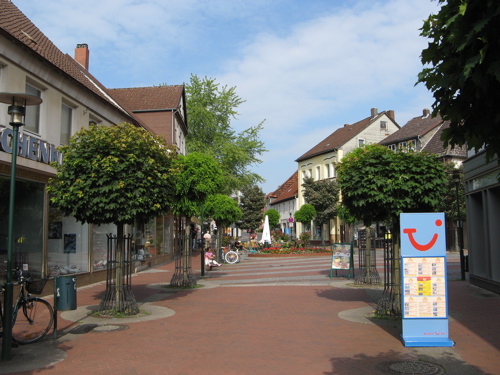
The next day, Elyse spent the school day at the partner school.
Getting up at 6 a.m. again was a good reminder of what she's
"missing" this year! The school has about 1000 students, from 5th
through 13th grade. It
was built about the same time as Mansfield Middle School, so it
has a similar "flat" architecture (it looked a lot like the
school she volunteered at here in Heidelberg, too). One of the
nicest parts of the school is the student art decorating the halls (see
samples below left and center). They recently added grades 5 and
6 and had installed a climbing contraption (below, right) that Elyse
thought looked pretty fun (no, she didn't try it)!
HEIDELBERG
We don't feel like we've been around
Heidelberg all that much lately,
but we
have managed to do some fun things around town. Our German class
meets two evenings per week. We were correct to move into the lower
level course, and enjoy being with our friends there, too! We
were
spoiled with Ellen, our teacher from the last course, so this
teacher doesn't seem as dynamic and isn't likely to take us as far, but
it is fun to be learning and practicing the language a bit. We
laughed the other day in class. We have been told numerous times
- including in class that evening - that in German the verb is always
in the second position of a sentence (after the subject - which might
have multiple words - like "his new, black dog"). However, then the
teacher pointed out the words like "but" and "and" can go in position null / zero. We're wondering if there will end up being a "position negative one" in later lessons!
Anyway, on other days we've discovered different paths to - and areas around - the
castle to explore, and we've continued to take advantage of the
cultural offerings of the city. We got to go to another concert at the beautiful
Alte Aula (pictured in
our April page from our evening out with Julie & Kathy). This
was a benefit concert - from what we could translate - for a
program for homeless / jobless folks that was free for international
students and visitors (although they asked for donations for the
organization - wouldn't be much of a benefit concert otherwise, ay?).
It was a single pianist and he performed pieces by Schubert,
Beethoven and Chopin, as well as a piece that he had composed that was
also beautiful.
Elyse joined the Wednesday "coffee clutch" group (described in March's
page) for a tour of the Botanic Gardens, which are right behind where
we live. It was dreary day and she knew she would have to leave
early to get to the German class on time, but it was worth the short
visit (although she regrets not taking the camera!). The
department is one of the oldest in the University - over 400 years old
- and the gardens were originally established as a medical garden.
Eventually the gardens were separated from the Medical program
when Botany became its own subject. The Gardens contain over
14,000 species of plants, including over 4,000 orchids alone! All
of the plants/seeds were gathered (versus purchased), and there is a
special emphasis on Madagascar because of the interests/excursions
of a few of the professors. A few interesting tidbits of trivia
that might come in handy one day (or that stuck in Elyse's mind,
anyway).... insects cannot see red, so red flowers are only pollinated
by birds and bees. Bumble bees are apparently the smartest
insect; for example, they will remember a source of pollen after just
one encounter. The tour guides showed us a few interesting plants that
very clearly demonstrated evolutionary principles. One orchid's
"basin" (the bottom of the flower) traps the nectar, attracting bees to
it. However, after the bee goes in, it can only get out through a
small exit where the pollen and stamen are - "forcing" the bee to take
the pollen with it. Similarly, another orchid-type flower looks
like a very marbled beef-steak, thereby attracting flies. The files
also are "forced" through an exit where they get covered with the
pollen. The guides also showed us a plant that is called the
Traveler's tree that is related to the Strelitzia (Bird of
Paradise), but is huge. It had been thought that the name was due
to water being trapped among the bases of the "leaves" of the tree, but
it is actually because the leaves always are facing the East-West
direction! It took until only 15 years ago for them to figure out
who served as pollinator for these guys - Lemurs! Anyway, there are
many things to see and learn there, but Elyse had to leave. We
will try to get back for a "regular" visit to the Gardens sometime.
The Sunday we returned from Pisa was a beautiful day - sunny, warm and
a soft breeze - so we decided to take our lunch and hike to the top of
the hill above the Philosophenweg to a place called Heiligenberg (Holy
Mountain). We had been told there was an amphitheater there, along
with some ruins of a basilica, along with nice views of Heidelberg.
The hike is all through forests, so we had good shade, various
beautiful bird calls and fantastic smells the whole way. We were
surprised at the size of the "Thingstätte" or amphitheater when we
came upon it. Apparently it can hold 8,000 people and is often
used for parties (e.g., on May Day) and even some more organized
events. It was originally built in 1935 by the Nazis using forced labor
and was one of many planned for around the country that would
allow for events that reflected back on ancient German pagan rituals.
It was bizarre to have it "appear" in the woods and still
seemed to emanate evil. We couldn't bring ourselves to walk
through it and left pretty quickly.
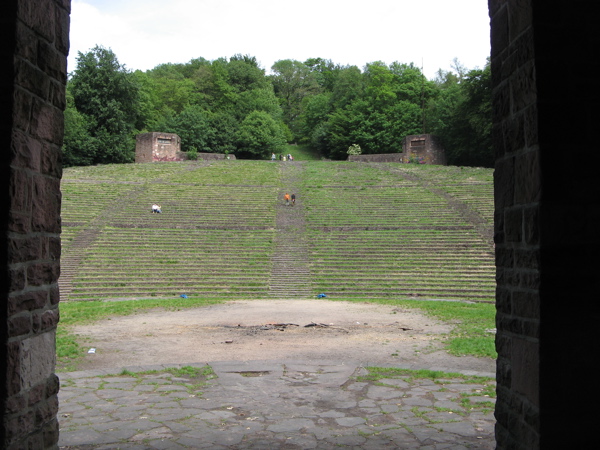
The next surprise was much more
pleasant! In 863, a monastery called St. Michael's was established
within the double walls of a Celtic fortress on the top of
Heiligenberg. It is all in ruins now, but they have put up signs
explaining what each room was used for (with cute drawings of monks
carrying out whatever activity would be
appropriate - eating, warming feet, drawing water from the well, etc.).
The church part of the monastery was actually built on top of an
old Roman temple (a lot of history in these parts!). You can see
the outline of the temple (perpendicular to the layout of the
monastery) in the middle of the map on the left and in the picture
below - the arched top on the left is the most visible. We had a
nice picnic and walk around and had fun watching and listening to kids
playing hide-and-(go)-seek among the ruins. Great spot for it!
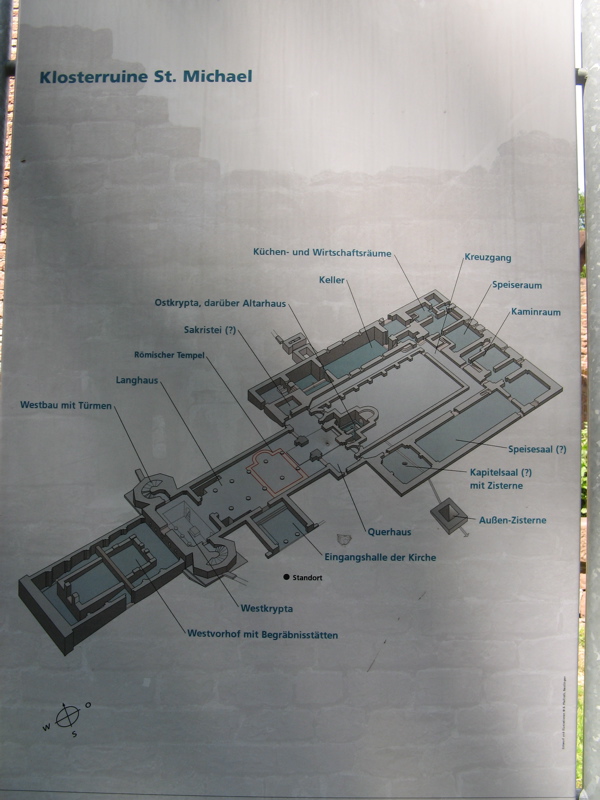
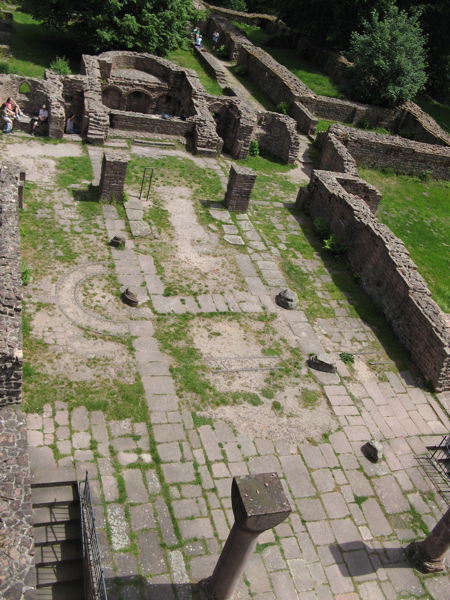
The walk down was wonderful and we even
found another tower - at another ruined monastery called St. Stephens -
with beautiful views of old Heidelberg. You'd think we'd be bored
by this view by now, but it still takes our breath away!